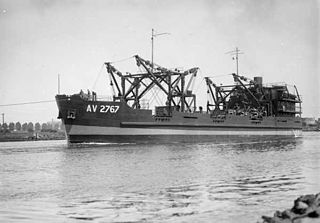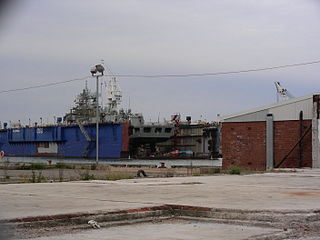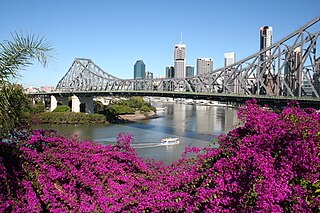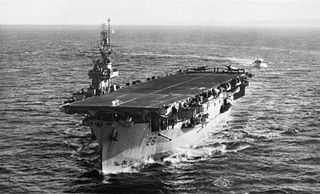
A dry dock is a narrow basin or vessel that can be flooded to allow a load to be floated in, then drained to allow that load to come to rest on a dry platform. Dry docks are used for the construction, maintenance, and repair of ships, boats, and other watercraft.

Pembroke Dock is a town and a community in Pembrokeshire, South West Wales, 3 miles (4.8 km) northwest of Pembroke on the banks of the River Cleddau. Originally Paterchurch, a small fishing village, Pembroke Dock town expanded rapidly following the construction of the Royal Navy Dockyard in 1814. The Cleddau Bridge, a toll bridge links Pembroke Dock with Neyland.

Garden Island is an inner-city locality of Sydney, Australia, and the location of a major Royal Australian Navy (RAN) base. It is located to the north-east of the Sydney central business district and juts out into Port Jackson, immediately to the north of the suburb of Potts Point. Used for government and naval purposes since the earliest days of the colony of Sydney, it was originally a completely-detached island but was joined to the Potts Point shoreline by major land reclamation work during World War II.

The Cockatoo Island Dockyard was a major dockyard in Sydney, Australia, based on Cockatoo Island. The dockyard was established in 1857 to maintain Royal Navy warships. It later built and repaired military and civilian ships, and played a key role in sustaining the Royal Australian Navy. The dockyard was closed in 1991, and its remnants are heritage listed as the Cockatoo Island Industrial Conservation Area.

HMAS Kuttabul is a Royal Australian Navy (RAN) base located in Potts Point in Sydney, New South Wales, Australia. Kuttabul provides administrative, training, logistics and accommodation support to naval personnel assigned to the various facilities that form Fleet Base East, the main operational navy base on the east coast of Australia. A part of Fleet Base East itself, Kuttabul occupies several buildings in the Sydney suburb of Potts Point and in the immediately adjacent Garden Island dockyard. It also supports navy personnel posted to other locations throughout the greater Sydney region.
The Queensland Maritime Museum is located on the southern bank of the Brisbane River just south of the South Bank Parklands and Queensland Cultural Centre precinct of Brisbane, and close to the Goodwill Bridge.

Esquimalt Royal Naval Dockyard was a major British Royal Navy yard on Canada's Pacific coast from 1842 to 1905, subsequently operated by the Canadian government to the present day.

Bulimba is a suburb in the City of Brisbane, Queensland, Australia. It is located 4 kilometres (2.5 mi) north-east of the CBD, on the southern bank of the Brisbane River, and borders Balmoral, East Brisbane, Hawthorne, and Morningside. The 2011 Australian Census recorded a population of 5,941 increasing rapidly to 6,843 in 2016.

HMAS Diamantina (K377/F377/A266/GOR266), named after the Diamantina River in Queensland, is a River-class frigate that served the Royal Australian Navy (RAN). Constructed in the mid-1940s, Diamantina was active from 1945 until 1946, was placed in reserve, then was recommissioned as a survey ship from 1959 until 1980.

Crusader (AV2767) was an Australian Army amphibious operations support ship of World War II. She was launched shortly before the war ended and entered service in late 1945. From 1945 to 1947 she was mainly used to return Australian Army equipment from the islands off New Guinea. She was also loaned to the Australian Shipping Board in early 1947 and transported earth moving equipment and timber between Melbourne and Tasmania. However, the Army did not need a ship with Crusader's capabilities after the war, and she was sold in 1947 to the Queensland Cement and Lime Company which operated her as a coral barge on the Brisbane River until the mid-1980s. The ship was scuttled in 1986 and became a popular dive wreck.

Evans Deakin & Company was an Australian engineering company and shipbuilder.
Williamstown Dockyard was one of Australia's principal ship building yards at Williamstown, Victoria, Australia.

Sutherland Dock is a heritage-listed dockyard at the former Cockatoo Island Dockyard, Cockatoo Island, New South Wales, Australia. It was added to the Australian Commonwealth Heritage List on 22 June 2004.

South Brisbane Dry Dock is a heritage-listed dry dock at 412 Stanley Street, South Brisbane, City of Brisbane, Queensland, Australia. It was designed by William David Nisbet and built from 1876 to 1887. It is also known as the Government Graving Dock. It was added to the Queensland Heritage Register on 21 October 1992.

Forgacs Marine and Defence (Forgacs), former Forgacs Group, is a major Australian engineering and shipbuilding company. It has facilities at Newcastle, Sydney, Brisbane and Gladstone. The company employs 1000 people.
HMAS Waree (W128) was a tug boat operated by the Royal Australian Navy (RAN) during World War II. She operated as a tug boat for the Waratah Tug and Salvage Company before being requisitioned by the RAN in 1942, and operating in northern Australia and Papua. She sank on 17 October 1946 off the New South Wales coast while sailing to Sydney from Thursday Island.

Hamilton Reach is a reach of the Brisbane River in Brisbane, Queensland, Australia.



























